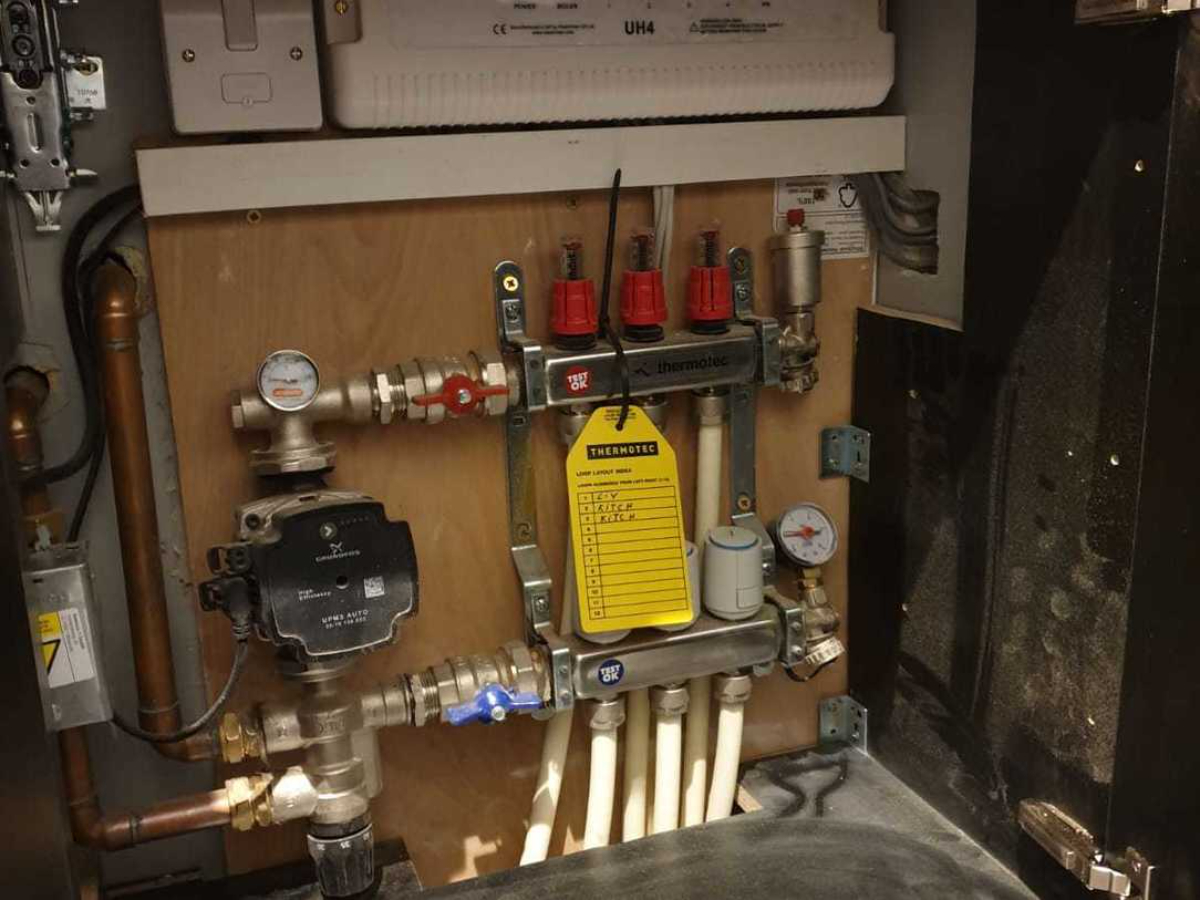Find out more about common electrical problems in the home? Faulty wiring, frequent power surges, tripped circuit breakers, flickering lights, and overloaded outlets are some of the most common electrical issues homeowners face.
This guide explores these problems, their potential causes, and how to identify warning signs before they become serious. Learn when to troubleshoot issues yourself and when to call a professional to ensure your home’s electrical system remains safe and efficient.
Frequent Power Surges
Power surges are brief spikes in electrical power and are among the common electrical problems in homes. They usually last only a few microseconds but can cause significant damage to electronic devices and appliances. Surges can be caused by several factors, such as faulty wiring, damaged power lines, or issues with the electrical grid itself. Additionally, using electrical appliances with high power requirements can contribute to surges. To prevent frequent power surges, ensure that your home’s wiring is in good condition.
Regularly check for any signs of wear or damage. Look for scorch marks around outlets or switches, which may indicate an underlying issue. Installing surge protectors for your electronic devices is a good way to protect against these spikes. A surge protector will divert excess voltage away from your devices, keeping them safe.
It's also crucial to avoid overloading your sockets with too many devices, as this can strain your electrical system. Spread out your usage by using multiple outlets. If you experience frequent surges, contact a professional electrician to inspect your electrical system and address the root cause of the problem.
Lastly, consider investing in a whole-house surge protector. This device is installed at your main electrical panel and provides increased protection by blocking surges before they can enter your home’s wiring. Proper maintenance of your electrical system and the use of protective devices can significantly reduce the risk of power surges and safeguard your valuable electronics and appliances. For further guidance, it is recommended to seek advice from a professional electrician who can assess and manage your specific situation.
High Electricity Bill
A high electricity bill can be a sign of underlying electrical issues in your home. There are several reasons why your energy consumption may be higher than usual. These include faulty wiring, inefficient electrical appliances, or even electrical leaks where electricity escapes from circuits.
One potential cause of high electricity bills is the use of old or inefficient appliances. Older devices often consume more power to operate compared to newer, energy-efficient models.
To mitigate this, consider upgrading your electrical appliances to designs that are better built for energy conservation. Newer appliances come with energy ratings that specify their efficiency, helping you make informed decisions when replacing old gadgets.
Another factor might be overloading circuits. When multiple appliances are connected to a single outlet or power strip, it can cause the circuit to overheat and consume more electricity. This not only affects your bill but also poses a fire risk.

Check your home’s circuit breaker regularly for any signs of overload and distribute the power load more evenly across different outlets in your home. Using dedicated circuits for high-power appliances like refrigerators and washing machines can also help reduce the risk of an overload. Faulty wiring is another major contributor to high electricity bills. Worn-out or damaged wiring does not conduct electricity efficiently, leading to higher energy use. If you suspect faulty wiring, it is crucial to get in touch with a qualified electrician to inspect your system.
They can identify any issues and carry out necessary repairs to ensure your wiring is up to code and functioning efficiently. Another tip to consider is regularly checking for any electrical leaks. These leaks occur when electricity escapes from wiring or circuits, resulting in wasted energy. This can happen due to damaged insulation or exposed wires. Timely detection and repair can prevent these leaks and lower your energy costs.
Taking steps to identify and address these issues can make a big difference in reducing your energy costs. Regular maintenance and timely upgrades are important actions to keep your electrical system running efficiently, ultimately leading to lower electricity bills and a safer home environment.
Electrical Shocks
Experiencing electrical shocks when touching a switch, outlet, or appliance is a clear indication of an electrical problem. These shocks occur when there is a fault in the wiring or a device is not working properly. Although most shocks are minor, they are a significant warning sign that should not be ignored.One common cause of electrical shocks is faulty wiring. Damaged or exposed wires can result in an electric shock when touched. Make sure to routinely check the wiring in your home for any damage or wear.
If you notice any issues, it is important to call an electrician immediately to fix the problem. Another cause could be the improper grounding of electrical appliances. Grounding helps in directing any excess electricity safely into the ground, rather than allowing it to pass through you. If your electrical appliances are not properly grounded, they can pose a serious risk of electric shock.
Using damaged or worn-out devices can also lead to shocks. Over time, the insulation around wires inside appliances can degrade, increasing the risk of electrical faults. Regularly inspect your electrical equipment for signs of wear and tear, and replace any damaged items promptly.
Overloading
Overloading is a common electrical problem in many homes. This occurs when too many devices are plugged into a single outlet or extension, causing the circuit to draw more power than it is designed to handle.
Overloading can result in circuit breakers tripping, overheating, or even electrical fires. An overloaded circuit is often identifiable by signs such as frequently tripped breakers or fuses and warm or discoloured outlets.
If you notice these signs, it is crucial to address the problem immediately to avoid more serious issues.
To prevent overloading, avoid using a single extension cord or power strip for multiple high-energy devices. Distribute your electrical load by plugging devices into different outlets.
Additionally, ensure that your home has adequate power points to meet your electrical needs, and consider upgrading your electrical system if necessary. It is also essential to understand the load capacity of your circuits and not to exceed them.

Regularly check your circuit breaker panel for signs of wear or any unusual activity. If you are unsure, seeking the help of a professional electrician is advisable. They can assess your electrical system and recommend the necessary upgrades to ensure your home can safely handle its electrical load. Another preventive measure is to be mindful of the types of devices you are plugging in.
High-energy devices, such as space heaters, microwaves, and hair dryers, should be plugged directly into wall outlets rather than extension cords or power strips. Using surge protectors can also safeguard your appliances from potential power surges, which can be caused by overloaded circuits. Surge protectors help to manage the electrical load and provide additional protection against power spikes.
Routine maintenance of your electrical system can prevent overloading. This includes having a professional inspect your wiring, outlets, and overall electrical setup. Keeping your electrical system in good working order will ensure that it can handle the demands of modern living without risking safety. In summary, understanding the dangers of overloading and taking the necessary precautions are vital for maintaining a safe home. Regular inspections and possibly upgrading your electrical system can prevent overloading and safeguard your home from potential hazards.
Flickering Lights
Flickering lights are another common electrical issue that many homeowners encounter. This problem can be bothersome and may indicate a serious underlying issue in your home’s electrical system. Several factors can cause flickering lights, including loose wiring, faulty light bulbs, or overloaded circuits. To determine the cause, start by checking the light bulb.
Sometimes, a loose or failing bulb can cause flickering. Simply turning the bulb to ensure it is properly seated may resolve the issue. If the flickering continues, it may be a sign of a more severe problem.
Loose wiring is another frequent cause of flickering lights. Over time, wiring connections can loosen, leading to intermittent power supply and flickering lights. This issue can be dangerous and should be addressed by a professional electrician to prevent potential fire hazards.
Overloaded circuits can also lead to flickering lights. When a circuit is carrying too many electrical devices, it can struggle to supply adequate power, causing flickers. Redistribute the electrical load by plugging devices into different circuits or make use of additional circuits if you find that overloading is a recurring issue in your home. If you cannot identify the cause of the flickering lights or if the issue persists, it’s important to contact a qualified electrician to inspect your wiring and circuits.
Looking for reliable domestic electrician services in Surrey? Redwood Electrical Services is a team comprised of experienced and qualified electricians in the Woking, Guildford, and Cobham areas. Our team delivers friendly and professional electrical services, whether you're dealing with small issues like changing lights or larger projects like full house rewiring.






